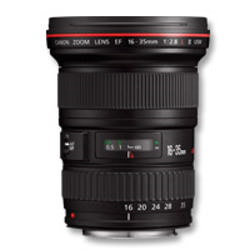1. What do the pros know about shooting with a wide aperture, such as f/2.8 on the Canon 16–35mm, that you should know? A wider aperture gives you more control of depth of field and allows you to shoot in low light conditions without a flash. These are often two of the significant differences between amateur and professional digital photography.

2. Depth of field and using available light are important tools for photojournalists. With the f/2.8 aperture available on the Canon EF 16–35mm, they can render the background with a smooth, unfocused blur that allows the focus of the news story to pop from the photo. The rounded aperture opening also contributes to the excellence of the bokeh produced by this lens. Photojournalists often find themselves shooting where the light is low, but a flash would intrude on the subject as well as the other news photographers. That’s why so many of them seriously consider the Canon EF 16–35mm when selecting a lens built for their profession.
3. Equally important to photojournalists and many pros in a lens of this type is that it is built for rugged use. It isn’t unusual for the angry subject of a crowd of news photographers to place his or her hand on a lens and push the photographer, or even snatch and throw a camera to the ground. Canon has built the EF 16–35mm just for these occasions, with primarily an all-metal construction and just enough weight (22.5 oz./640g) to make it tough, but can be carried all day. Canon also added a number of rubber gaskets to make this lens weather- and water-resistant.
4. Pros also demand lenses with quiet and fast auto-focus (AF) motors. Canon’s Ultra-Sonic Motor (USM) on the EF 16–35mm includes new AF algorithms for a very speedy, half-second turn of the complete focus ring and just as quick point-to-point focusing.
5. For news pros and architectural, travel and nature photographers, a lens of this type must be judged on its performance, beginning with sharpness. Without hesitation, the Canon EF 16–35mm delivers clean, crisp and precise images. As with all zoom lenses, even professional-grade, with these short focal lengths, there are areas of softness throughout the aperture and focal length ranges, simply because the glass elements in a wide-angle lens must be made with a substantial curve. The Canon 16–35mm is no different, requiring the company to find the best compromise between ultimate sharpness and keeping aberrations and distortions to a minimum.
It’s no surprise, therefore, that this Canon lens has soft corners at its widest focal length, or 16mm. They disappear, however, when the lens is zoomed to 20mm (not much of a difference). There is less corner softness at 16mm and f/2.8 than 16mm at f/4 and f/5.6. Third-party tests confirm optimum sharpness at approximately 24mm at f/5.6. As an upgrade of the older Canon 16–35mm f/2.8L (without the II designation), the newer lens delivers much more consistent sharpness at all focal lengths at f/2.8.
6. Lens performance is also measured according to chromatic aberration, vignetting and distortion. Chromatic aberration on the newer Canon 16–35mm f/2.8L is noticeably improved compared to its predecessor. Again, this occurs at the widest angle and at f/2.8. Aberration is a bit more evident when the lens is used with a full-frame body, at 16mm and f/2.8; however, it quickly diminishes at higher f-stops.
7. What minor vignetting there is on this lens follows the same pattern: As soon as the lens is moved to f/4 and more than 20mm, the corners exhibit only a loss of a quarter stop of light.
8. Canon has included three aspherical elements among the total of 16 glass elements in 12 groups. Each aspherical element is different, ground, replica and GMo, which help to control distortions that are “natural” to wide-angle lens of short focal lengths. Barrel distortion and pincushioning are negligible on less-than-full-frame bodies, but more noticeable on full-frames. Whatever distortion is recorded in a RAW image, photo-editing software can easily correct it.
9. The Canon EF 16–35mm f/2.8L II USM Zoom lens is available from Amazon HERE.
This article about "Canon EF 16–35mm f/2.8L II USM Zoom Lens" was first published on our website here https://www.photographytalk.com/photography-equipment-reviews/2005-9-reasons-to-learn-from-the-pros-who-shoot-with-a-canon-ef-1635mm-f28l-ii-usm-zoom-lens35